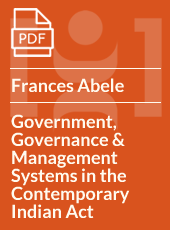FEATURED: Centre Research

The Jurisdiction of Inherent Right Aboriginal Governments
Kent McNeil | Osgoode Hall Law School
October, 2007 | Aboriginal governments have the authority to become engaged on a government-to-government under existing Canadian law and do not have to seek permission to exercise their jurisdiction from the federal government, provincial governments, or Canadian courts.

Like An Ill-Fitting Boot: Government, Governance And Management Systems In The Contemporary Indian Act
Professor Frances Abele | Carleton University
June, 2007 | This report finds that the Indian Act appears to be a legislative fossil. Its emphasis on the authority of the executive branch of the federal government over individuals and communities shapes virtually every aspect of governance. This limits the ability of Band governments to be responsive to their members.

The Crown’s Constitutional Duty to Consult and Accommodate Aboriginal and Treaty Rights
Honourable Madam Justice Maria Morellato | Supreme Court of British Columbia
The Crown’s duty to consult and accommodate Aboriginal and treaty rights is a fundamental matter of social justice that invokes very solemn legal obligations. Reconciliation and win-win situations can be achieved with good faith negotiations if the federal and provincial Crown immediately endorses and commits to a significant change in their current consultation and accommodation policies and practices. Our courts have established and developed legal principles concerning enforceable Crown obligations that provide shape and substance to the consultation and accommodation process. The courts have also underscored the need for reconciliation and negotiated solutions to outstanding aboriginal title and treaty rights disputes. Aboriginal peoples are entitled at law to have a clear and decisive voice in Crown decisions that may impact, not only the use and disposition of their traditional lands and resources, but also their social and cultural well-being. Unilateral decision-making by the Crown is no longer legal in this context. At the heart of the Crown’s legal responsibility to consult and accommodate aboriginal and treaty rights are choices made every day by Crown leaders and officials which very seriously impact, not only fundamental constitutional rights, but the very health and well being of hundreds of thousands of women, men and children living in Canada.

The Indian Act And The Future Of Aboriginal Governance In Canada
Historian Ken Coates | University of Saskatchewan
It is important to understand both the origins and impact of the Indian Act. The Indian Act reflected the core assumptions held about Indigenous peoples by the dominant Euro-Canadian society in the mid to late 19th century. Its basic premises, summarized as providing for “civilization, protection and assimilation,” were that the Government of Canada viewed Aboriginal people as wards, that Indigenous communities and governments were incapable of managing their affairs, that the nation sought eventually to integrate Indigenous cultures into the Canadian mainstream, and that the First Peoples had to be separated from the rest of Canadian society until they were ready for the transition. The Indian Act was, and is, a powerful tool in the hands of the federal government, giving federal civil servants the authority to manage band affairs, supervise Indigenous lands and trust funds, direct the personal and family lives of individual Aboriginal people, and deny basic Canadian civil and personal rights to hundreds of thousands of “wards” of the federal state.

The Structure Of The Indian Act: Accountability In Governance
Associate Professor Shin Imai | Osgoode Hall Law School
The Indian Act has been criticized for giving Chief and Council too little power to make their own decisions. The Act has also been criticized for giving Chief and Council too much power to make decisions. Some people point out that Chief and Council do not have enough accountability to members of the community. The fact is, both criticisms are valid. This report shows how the structure of the Indian Act creates this contradictory state of affairs and how to avoid such contradictions when the First Nation moves out of the Indian Act to a more suitable First Nation designed government system. A government system designed by First Nations will see a much reduced or eliminated role for the federal government. But this will not be enough. The First Nation government system should also deal with ways to ensure that Chief and Council use their powers in a good way. There are three ways to control the powers of Chief and Council. First, Chief and Council should be accountable to the community members. Second, the decisions of Chief and Council should be consistent with core principles that are important to the community. Third, there must be a tribunal that is independent of Chief and Council that can certify and interpret the laws and can hear appeals from decisions.
